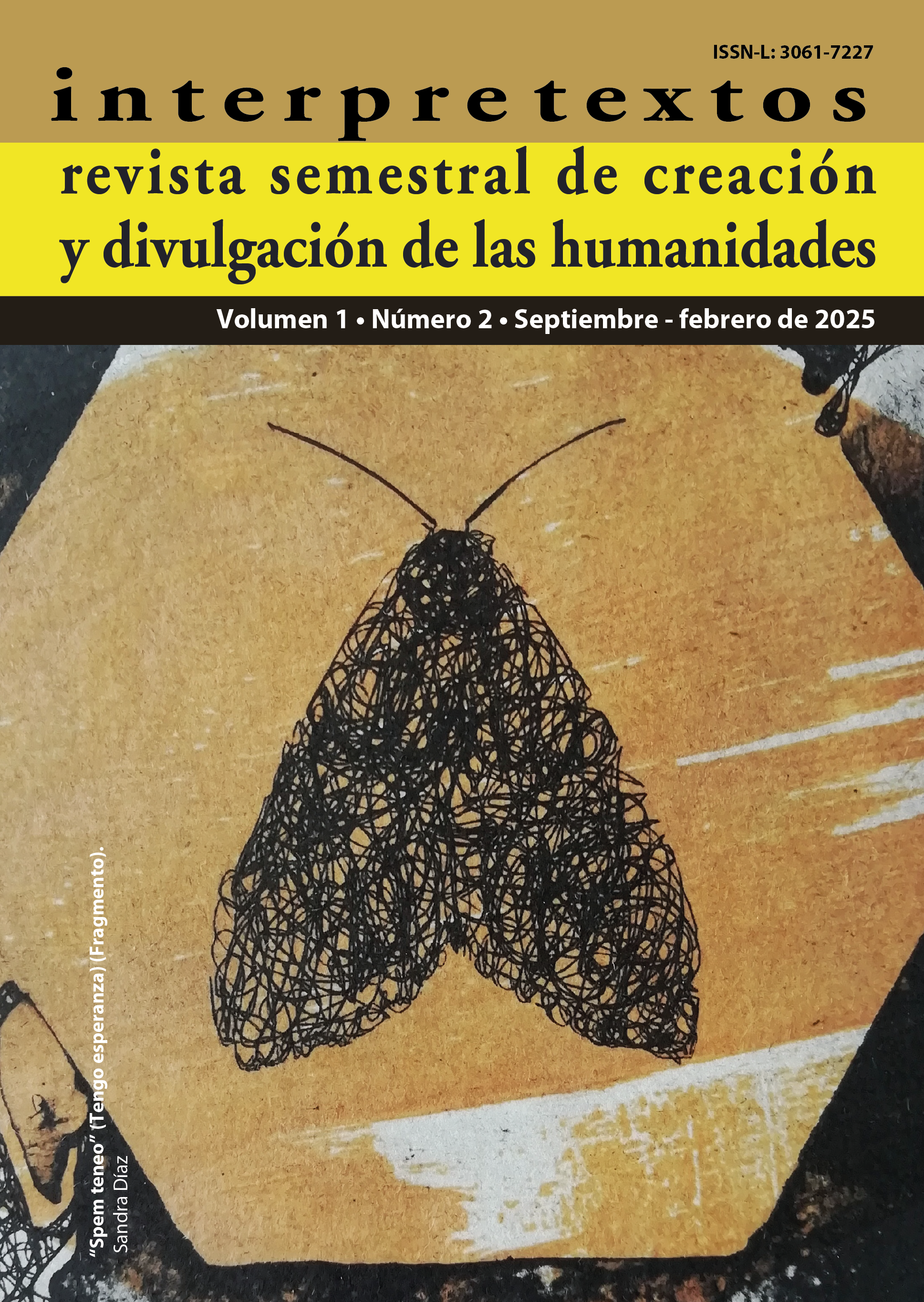La sombra del caudillo,
literatura y cine con personajes al margen de la ley
DOI:
https://doi.org/10.53897/RevInterp.2024.02.10Palabras clave:
Bandoleril, Revolución, Caudillo, extralegal, ejércitoResumen
El propósito de este artículo es analizar a los personajes representados al margen de la ley en la película La sombra del caudillo, thriller y drama político de Julio Bracho, basado en la novela de Martín Luis Guzmán, una narrativa bandoleril que resalta el cineasta en las figuras de autoridad e institucionalizadas como el Ejército mexicano, legitimadas por el soberano. La investigación se sustenta desde el modelo de los Elementos de Análisis Cinematográficos de Lauro Zavala, con una interrelación de los hechos históricos que contextualizan la novela y los hechos de actualidad que sucedieron en el periodo en que el director intenta proyectar y difundir el filme,
censurado por la hegemonía militar y los presidentes en turno durante 30 años para cubrirse las espaldas, no tanto por la masacre en Huitzilac al final de la cinta, sino por la represión de la milicia a diferentes sectores sociales en los años anteriores y posteriores a la filmación, lo que ponía en entredicho la imagen patriótica del Ejército, de sus generales y del mismo comandante supremo de las
Fuerzas Armadas.
Descargas
Métricas
Citas
Blanquel, E. (2000). La Revolución Mexicana. Historia mínima de México (2ª ed.). El Colegio de México, pp. 137-152.
Córdova, A. (2015). La fundación del partido oficial. Revista Mexicana de Ciencias Políticas y Sociales, 39 (155), pp. 143-171. DOI: https://doi.org/10.22201/fcpys.2448492xe.1994.155.50638
Corominas, J. y Pascual, J. (1984). Diccionario crítico etimológico castellano e hispánico. Editorial Gredos, p. 711.
Curiel Defosse, F. (1987). La querella de Martin Luis Guzmán. (Tesis de Maestría). Universidad Nacional Autónoma de México, México. Recuperado de https://repositorio.unam.mx/contenidos/77796
Guzmán, M. L. (1997). La sombra del caudillo. Porrúa. México.
Hernández, B. (11 de septiembre de 2021). Combate en Malpaso: los primeros muertos de la Revolución. Crónica. https://www.cronica.com.mx/notas-combate_en_malpaso__los_primeros_muertos_de_la_revolucion-1203260-2021.html
Ibarra, J. (2006). Los Bracho: tres generaciones de cine mexicano. Universidad Nacional Autónoma de México.
Legrás, H. (2003). Martín Luis Guzmán: el viaje de la revolución. MLn, pp. 427-454. DOI: https://doi.org/10.1353/mln.2003.0046
López Vera, E. E. (2014). La sombra del Caudillo: Una reflexión sobre la tiranía. Revista de El Colegio de San Luis, 4(8), pp. 218-241. DOI: https://doi.org/10.21696/rcsl482014422
Martínez Assad, C. (2020). La censura de una historia. Relatos e historias en México, (95). https://relatosehistorias.mx/nuestras-historias/la-censurade-una-historia
Meertens, B. (2014). El estereotipo del bandido social en dos novelas de la Revolución Mexicana: Análisis de Los de abajo de Mariano Azuela y La sombra del caudillo de Martín Luis Guzmán. Studenttheses, Universidad de Utrecht. https://studenttheses.uu.nl/bitstream/handle/20.500.12932/17653/sdfrtsyy%2Cjrstrj%2Cy-1.pdf?sequence=2&isAllowed=y
Mendoza García, J. (2011). La tortura en el marco de la guerra sucia en México: un ejercicio de memoria colectiva. Polis, 7(2), 139-179. http://www.scielo.org.mx/scielo.php?script=sci_arttext&pid=S1870-23332011000200006&lng=es&tlng=es.
Pellicer, J. (2016). Julio Bracho: La sombra del caudillo (1960). Iberoamericana Vervuet, pp. 323-337. https://www.iberoamericanavervuert.es/capitulos/9783954878543_015.pdf DOI: https://doi.org/10.31819/9783954878543-016
Torres Alonso, E. (2016). La sombra de Martín Luis Guzmán. Política, historia y literatura como testimonio. Balajú, revista de la Universidad Veracruzana, 4(3), p. 120. DOI: https://doi.org/10.25009/blj.v0i4.2214
Zavala, L. Elementos de Análisis Cinematográfico. En Elementos del discurso cinematográfico. Universidad Autónoma Metropolitana, pp. 42-47. https://tallerdelaspalabrasblog.files.wordpress.com/2016/03/zavala-elementosdel-discurso-cinematogrc3a1fico.pdf
Descargas
Publicado
Cómo citar
Número
Sección
Licencia
Derechos de autor 2024 Julio César Zamora Velasco

Esta obra está bajo una licencia internacional Creative Commons Atribución-NoComercial-CompartirIgual 4.0.
Revista Interpretextos permite compartir, copiar y redistribuir el material en cualquier medio o formato; adaptar, remezclar, transformar y construir sobre el material, dando crédito a la obra de manera adecuada y proporcionando un enlace a la licencia, indicando si se han realizado cambios.











